
Fae Tactics Review
Indie Turn-Based Tactical RPG is a string of words that can be hard to get immediately excited about. In a genre with legacy stalwarts like Final Fantasy Tactics and darlings like Fire Emblem, to be able to carve out an identity within such a crowded space is undoubtedly a challenge. When Fae Tactics was announced earlier this year, its16-bit graphical style immediately piqued my interest, but part of me expected it to be a bunch of borrowed ideas that other games have simply done better. Needless to say, I was very wrong.
Underneath its colorful, GBA-style exterior is one of the most challenging and inventive SRPGS I've played in years.
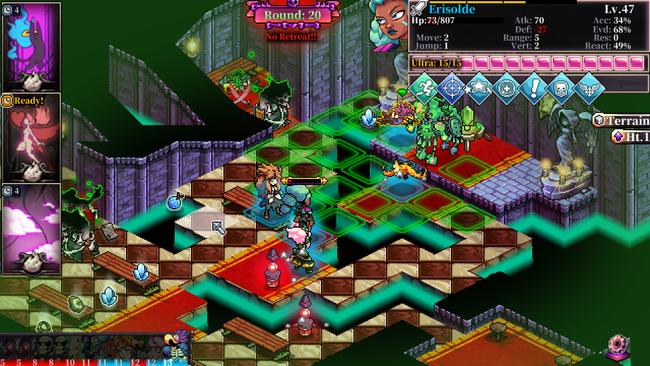
Fae Tactics stars a young girl named Peony on a search to find her missing mother. While the story starts out with this very limited scope, it slowly and steadily ramps into a multifaceted narrative that incorporates a surprisingly large number of characters and locations, each with their own through-lines and motivations. The colorful artstyle and straightforward opening had me initially expecting a simple Saturday-morning-cartoon style story without much in the way of nuance or grey-shaded storytelling. While it doesn't nearly reach the highs of, say, Tactics Ogre, I found myself pleasantly surprised at how openly it tackled themes of guilt and responsibility, and how it incorporated some surprisingly mature topics that almost betray the game's bubblegummy exterior. Some dialogue still feels fairly bluntly written, but the story ended up being better than I expected going in, especially considering a fairly weak opening few hours.
While the front-to-end plot did end up surprising me, one of the more particularly interesting aspects of Fae Tactics is just how non-linear it is as a whole. Within a few hours of playing, multiple locations will open up as destinations on the menu, each carrying forward a specific thread of events centered around a certain region or character. I've always personally loved this style of storytelling, where the world itself ends up carrying a larger portion of the overall narrative, instead of each region simply being a pitstop on the way to an ultimate destination. Each region in Fae Tactics will introduce new party members, new enemies, and both mainline and substory quests. Despite fanning out like this early on, each area will smartly introduce aspects that will be followed up with elsewhere, truly making the overall plot feel like an interconnecting set of puzzle pieces rather than themed lanes that rarely intersect.
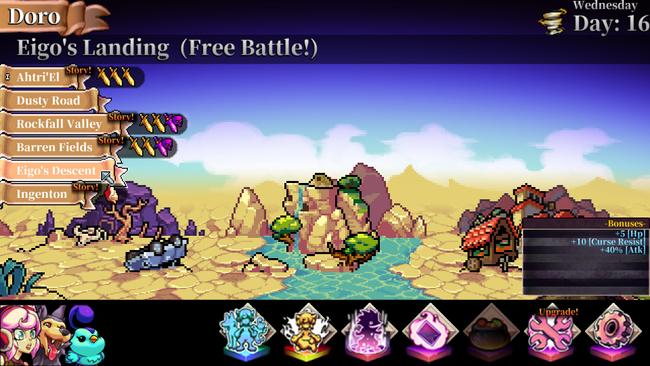
In Fae Tactics, the player determines their battle party in two groups, Leaders and Summons. Leaders are the traditional party members that one would expect in a tactical-style game -- story-based characters with specific strengths and abilities. Leaders include main characters like Peony and her dog Chico, as well as side characters such as the gloved boxing chicken Pichon (you read that right) or the centaur archer Orowantus. Certain characters are better suited for absorbing damage and fighting up close while others are best used dealing high damage from a distance. So far, it sounds like a familiar take on a well-worn game type, but beyond this basic outline is where Fae Tactics begins to diverge from its inspirations.
Outside of selecting a trio of leader units, Peony can also summon up to three 'fae' monsters for any given battle. Fae summons are essentially pokemon, who Peony can enlist to assist in battle once they have been previously defeated. Summoned units are treated just like party members, they'll take turns in battle as would any other character. Certain summons, like dragons, are meant to be physical damage dealers while others are more support-oriented, able to reduce incoming damage or heal from the backline. Having a divided pool of story characters and summons that are independent of each other is a cool balancing act that circumvents a usual hangup I have with tactical games with summoning or beastmaster mechanics -- usually, I would never want to swap out an actual character with a generic monster, but here you're bringing both along all the time.
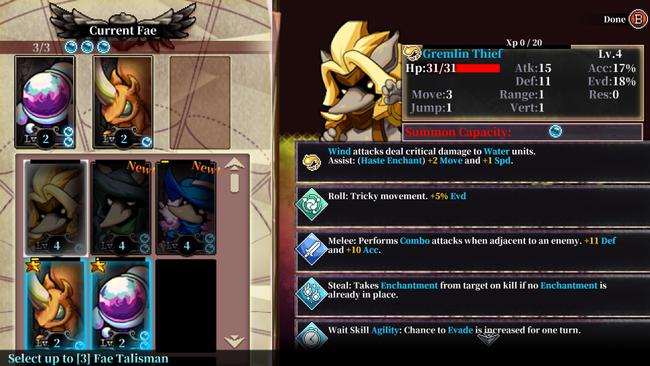
Battles themselves take place in a series of rounds. Each round, all enemy and allied units are allowed to take one turn consisting of their movement and an action in the order depending on their speed. Actions themselves are entirely context-dependent, you'll never select from a menu. Selecting an enemy unit will initiate an Attack ability, while selecting an allied unit will use an Assist ability instead. Even waiting in place will kick off a literal 'Wait' skill, such as increasing the damage done on the next turn or regaining a little bit of lost health. Each Leader and Summon unit will have unique Attack, Assist, and Wait abilities, so these undoubtedly play a huge role in determining a specific lineup to suit any given strategy.
Each Leader, Summon, and enemy also have an assigned element in most cases, such as Fire, Ice, and the like. Smart use of elemental advantages (again, similar in nature to Pokemon) is probably the single most critical aspect to keep in mind when strategizing for any particular battle. Units with elemental advantages, such a Fire unit attacking an Ice unit, will automatically critically hit. A unit's assigned element will also determine its assist and reaction abilities. Based on both story and sidequest completion, Leader units will be able to change their weapons which will alter their element and manner of attack. Peony's talisman can also cast spells independent of her actual turn, which can do anything from healing a downed unit to damaging every enemy on the field.
There's a lot to keep in mind, and even partway through my second playthrough I was still discovering combinations of leaders, summons, spells, and elements that synergized into effective strategies.
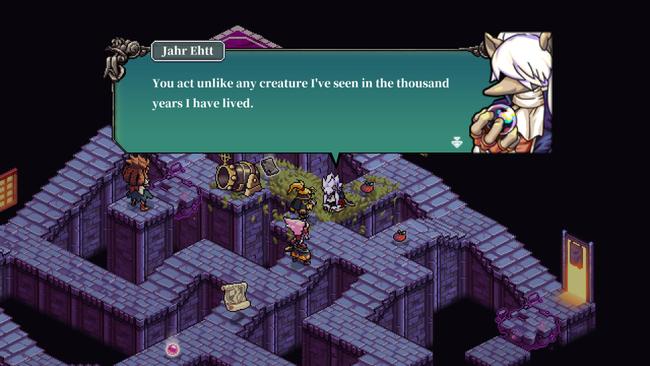
Beyond progressing through story encounters, players who venture off the beaten path might end up finding unique secret characters or hidden summons for fulfilling certain conditions or exploring certain areas. Certain story battles will even end up leading into optional content if completed with specific objectives intact. For instance, one battle in which Peony must escape from a jail will lead into a sidequest later if she manages to keep the other prisoners alive. Another storyline battle against a trio of Gorgon sisters ends up extending significantly if they are subdued instead of killed. New storylines will also appear simply for using a particular leader enough times in combat. While some players might bristle at the thought of missable content, I found that I appreciated the boldness of not overly-signposting every possible unique event. Even after completing the game twice, I know of one secret unit I haven't managed to recruit just yet.
Probably the most significant factor in my enjoyment of Fae Tactics was how smartly and surprisingly challenging it is, even on its Normal mode difficulty. Each boss encounter often has a unique mechanic which often forced me to change my strategy on the fly, whether it's forcing your units to reposition or simply dealing a lot of damage in short bursts. Maps vary from flat arenas with few obstructions to vertical cliff faces that require highly mobile or ranged units, and objectives vary from routing enemies to reaching an escape destination.
My first attempt at each of the more challenging battles would often result in coming up laughably short, but adjusting my Leader, Summon, and Spell loadout to match what was being asked of me would turn frustrating defeats into easy wins. Only in a few specific instances did the design of any particular challenge come across as unfair, typically as RNG-related mechanics such as an enemy unit teleporting to a random corner of the map once attacked. For the most part, recognizing a different tact better-suited to overcome a specific obstacle and then executing a new, effective strategy remained a rewarding experience from start to finish. Though you have to have thick enough skin to potentially fail on your first few attempts.
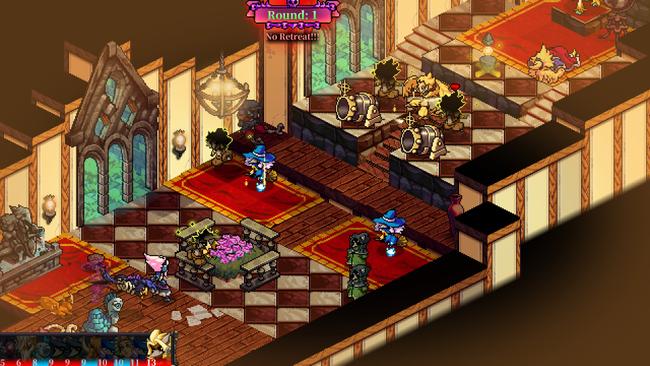
Fae Tactics is not really like other tactical RPGs that I've played, despite sharing a lot of foundational DNA as some of the greats. While other similar games have ended up feeling a fair bit more derivative, Fae Tactics's manages to stand out on pure inventiveness and imaginative structure. A unique narrative framework, distinct focus on summoning mechanics, high level of variety, and smartly-designed challenge makes Fae Tactics a near must-play for fans of tactical RPGs.